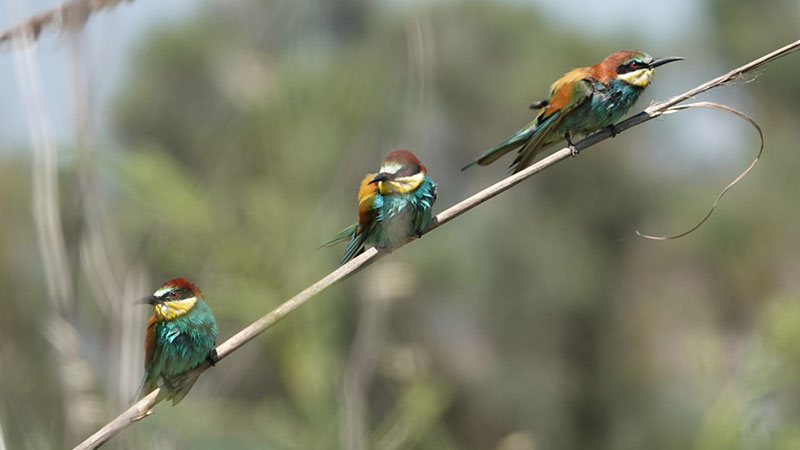WORDS Luis de Teves Costa
PHOTOGRAPHY Jeff & Dawn Godden
As temperatures rise and humidity drops in the Algarve, summer attracts visitors from around the globe. This works for people and wildlife alike.
Perhaps the most colourful animal you can find in the Algarve is the European Bee-eater (Merops apiaster). A spring and summer presence that flies from Africa to breed in the Algarve, other regions in Portugal, central Europe and Asia.
Nature was certainly creative when deciding on the palette of colours to use on this bird that looks like it has been coloured in sections much like on those paint-by-number colouring booklets and contemporary toys.
Unmistakably identified, the European bee-eater is a good bird for novice birdwatchers to look out for. They also capture the attention of wildlife photographers and enthusiasts for their bright rainbow plumage and amicable appearance.


Although easily identified as a species, gender is not as easy to differentiate. Males and females are extremely similar in size and colour and are nigh on impossible to recognise when observed in real-time unless you are a specialised ornithologist. In pictures, you can look out for the brown patches on their wings: males have a bigger and more predominant mark whereas, on females, this area is smaller and lighter.
As social birds, Bee-eaters have a distinct call that they use when perching or in flight. Once you have trained your ear for these particular sounds (pruiip ruiip), you will sometimes hear but not see these birds as they glide past you.
When in flight, they are agile and acrobatic, which is a requirement to catch flying insects in mid-air. Bee-eaters do prey on bees as the name suggests, but not exclusively. Dragonflies, bumble bees, wasps, beetles, flying ants, flies, grasshoppers and all sorts of other flying insects make up their crunchy diet. If there is a sting, they will whack the insect against a branch until the threat is disabled.

Bee-eater art work by Luis Teves Costa
(Although Beekeepers tend not to like these birds for obvious reasons, the presence and hunting of the European Bee-eater has little to do with the decline of honey-bee populations when compared to pests, colony diseases, pesticide use or other human interactions.)
Males will often present large insect snacks to females as part of their courtship during early spring. This feeding behaviour takes a more essential role later in summer when both parents have to feed their chicks. Pairs tend to be monogamous and stick together through their lifespan.
Usually, in colonies, these gregarious birds choose vertical river banks or hills near water to dig their horizontal tunnels about one metre long that end in a nesting chamber where the females lay their eggs. This choice of nest tries to deter raids from egg predators such as snakes and lizards. Adult Bee-eaters in the Algarve have few predators and only have to worry about occasional raptor birds.
As with most birds, “feather-keeping” is of utmost importance and requires regular dipping in water, mud and dust baths and lots of preening.
With the end of the summer and the arrival of cooler northern breezes, birds will once again migrate to winter in balmy equatorial Africa… until the next spring!













